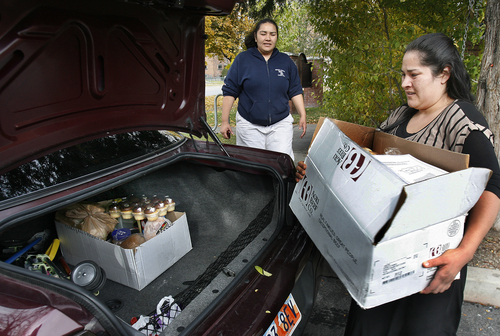This is an archived article that was published on sltrib.com in 2013, and information in the article may be outdated. It is provided only for personal research purposes and may not be reprinted.
The holidays mean hunger season at Utah's food pantries and this year the demand will be ratcheted up further when the federal food stamp program is reduced to 2008 funding levels beginning Friday.
For a family of four who qualify for the maximum level in the federal Supplemental Nutrition Assistance Program (SNAP), that will mean a decrease of $36, to $632 per month, according to the nonpartisan Center on Budget Policy Priorities in Washington, D.C.
In Utah, that will impact about 250,000 people, said Gina Cornia, executive director of Utahns Against Hunger. Nationally, that number is about 47 million. More than half the households that qualify for the food stamp program have children, she said.
"It sucks. It's hard," said Karmen Grover, a single mom with six children under her roof, including her 19-year-old daughter's 5-month-old boy.
Grover works 29 hours per week at West High School as a nutrition technician and said she would love to work more "but they won't let me because they'd have to provide insurance."
By the end of each month, Grover is out of food stamps and seeking help from the Crossroads Urban Center food pantry.
Her SNAP benefit could drop by about $50 a month, she said. "It's going to have an impact. If you looked in my fridge right now, you'd be surprised at what we're eating. It's pretty empty."
In 2009, the American Recovery and Reinvestment Act boosted SNAP benefits as the U.S. economy slid into the biggest recession since the Great Depression of the 1930s.
Cornia cited federal figures showing the number of Americans qualifying for food stamps jumped from 26 million in 2007 to 47.6 million in 2013.
The reduction is expected to save $5 billion during the next fiscal year and about $49 billion during the next decade.
At the Crossroads Urban Center, Rachel Fischbein, the emergency services director, said it's difficult to predict how the rollback will affect the food pantry.
"I know there will be an influx, but I don't know how much," she said. "We'll just have to see what happens."
For Mardalia Perez, who is unemployed and just reapplied for food stamps after relocating from Colorado, the reduced benefits will be felt by her four children, ages 15, 14, 12 and 6 months.
"It's bad news for us," she said. "It's hard this time of year because I have to pay bills for heat and electricity and that leaves less money for food."
And Perez said she spends a lot of money on gasoline searching for a job. "When the month is over, I won't have anything."
If demand increases substantially at Salt Lake Community Action pantries, food orders may have to be reduced, said Mary Richardson, neighborhood coordinator. In 2008, the five Community Action pantries provided aid to 18,000 households. By 2013, that number had jumped to 24,000, she said.
Making matters more difficult is holiday spending, said Ginette Bott, chief development officer at the Utah Food Bank.
Not only are big holiday meals expected, but also youngsters count on Santa Claus to come through. And that, too, means less money for food.
"People should be aware of the SNAP cutback and donate to [food] pantries," Bott said. "We know the holidays are a trying time. But the great thing about Utah is that the people here are so generous."
Twenty-year-old Kimberly Kropf has been on and off food stamps for three years. She is a single mom with a 3-year-old daughter and an 8-month-old son and works 12 hours a week.
"I'll have to get a second job," she said. The rollback in benefits makes her "very upset."
At the end of the month, she too is seeking help from the food pantry.
"I'm going to have to spend a lot more time looking for coupons and price-matching at Wal-Mart," she said. "Whatever is on sale, that's what we're going to eat."







